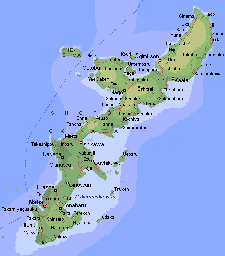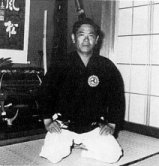It is very difficult to tell the true story about the development of the Okinawa Kobudo because almost all written documents about it were destroyed in the hard fightings, bombings and the outbreaks of fire that followed during the second world war. However, it seems that in the 12th century, regional lords called aji emerged and exerted power from their fortified manors called gusuku. Soon power was divided among three small kingdoms in 1326, which led to a lot of internal and continuous warfare until 1429. This was the best period to develop and perfect martial arts combat techniques.
 In 1429, Sho Hashi united the island and founded the Kingdom of the Ryukyus. During the 14th to 16th centuries, a period known as the "Golden Age of Trade", the Kingdom flourished as a trade center for China and other nations. However, trade vessels were constantly threatened by Japanese pirates and the Okinawa sailors needed to protect themselves while in foreign lands. Around 1580, Toyotomi Hideyoshi stated laws again that prohibited the possession or the carrying of weapons, in order to restore peace and bring some sort of prosperity to a resource poor Ryukyuan kingdom. It helped to prevent unnecessary loss of life among the people and was a deterrent to insurrection and civil wars. But that left the peasants of Okinawa more or less defenseless against the Samurai, which were the only ones allowed to carry weapons. Althought the empty hand techniques developped on the battlefields were very effective and refined, they were not so for use in massive defense or offense operations. In 1609, the Satsuma Samurai Clan attacked and swept the Okinawan defenses. The islanders used turtleshields and shortstrabbing daggers, but they were of very little use against horsebacked, swordcarrying samurai or bows. The only instruments the farmers had were their simple farmingtools. The unique martial arts of Okinawan karate and kobudo were born from this background. Over long years, the techniques of Chinese and South East Asian martial arts were incorporated into Okinawa Karate and Kobudo to establish the forms known today. The chinese methods were a combination of techniques with empty hands and with weapons like the San-Ku-Chu, ancestor of the Saï.
In 1429, Sho Hashi united the island and founded the Kingdom of the Ryukyus. During the 14th to 16th centuries, a period known as the "Golden Age of Trade", the Kingdom flourished as a trade center for China and other nations. However, trade vessels were constantly threatened by Japanese pirates and the Okinawa sailors needed to protect themselves while in foreign lands. Around 1580, Toyotomi Hideyoshi stated laws again that prohibited the possession or the carrying of weapons, in order to restore peace and bring some sort of prosperity to a resource poor Ryukyuan kingdom. It helped to prevent unnecessary loss of life among the people and was a deterrent to insurrection and civil wars. But that left the peasants of Okinawa more or less defenseless against the Samurai, which were the only ones allowed to carry weapons. Althought the empty hand techniques developped on the battlefields were very effective and refined, they were not so for use in massive defense or offense operations. In 1609, the Satsuma Samurai Clan attacked and swept the Okinawan defenses. The islanders used turtleshields and shortstrabbing daggers, but they were of very little use against horsebacked, swordcarrying samurai or bows. The only instruments the farmers had were their simple farmingtools. The unique martial arts of Okinawan karate and kobudo were born from this background. Over long years, the techniques of Chinese and South East Asian martial arts were incorporated into Okinawa Karate and Kobudo to establish the forms known today. The chinese methods were a combination of techniques with empty hands and with weapons like the San-Ku-Chu, ancestor of the Saï.
The stick techniques were already used by some okinawaian peasants who had to protect themselves against pillagers. Some new weapons were made using as example tools used from peasants, for instance the Nunchaku and the Tonfa or the Kama which was the unique tool with a metal part used at that time.
Varied distinct styles emerged during the heyday of the Ryukyuan kingdom: Shuri-ti forms were centered in the Ryukuan capital of Shuri, Naha-ti in the commercial center of Naha, and Tomari-ti in the Tomari district located between the first two. Each style had its distinguished masters who established the traditions preserved to our present day. The techniques of Karate and Kobudo were, by their nature, to be kept from the uninitiated.
Thus, there are but few historical records and the arts were conveyed almost entirely through personal oral transmission from master to disciple. Since the invasion of the Satsuma Samurai Clan, Okinawa was ruled by a weak government under orders of the Shogun, until the upcoming of the Meiji restoration, halfway the 19th century where, following the dissolution of the kingdom and the 1879 annexation of Okinawa as a prefecture, new institutions came into effect and Karate and Kobudo were incorporated into the Meiji public education system. There followed a movement to present these arts to the general public: during the Taisho Era (circa 1910-1926), demonstrations were made throughout mainland Japan, and in the early Showa years (circa main schools - ryu): Shorin-ryu, Gojyu-ryu, Uechi-ryu and Matsubayashi-ryu. Today, there exist many more sub-schools (ryuha) and factions (kaiha). Each boasts its own distinctive kata derived from the basic movements (kihon kata) common to all schools as the systematization of techniques of attack and defense.
Rigorous training over years cultivates both physical and spiritual strength. Thus these traditional arts contribute to building character, to fostering a sense of social responsibility, and to the healthy development of youngbodies and minds. In offering the disciplines of both martial arts and sports, Okinawa karate and kobudo today give inspiration to people throughout the world.
 Modern Kobudo was founded by Shinko Matayoshi (1888-1947), born in the Naha region from a wealthy family. His kobujutsu training began in his early teens and included kobujutsu, kamajutsu, ekujutsu, tonfajutsu and nunchakujutsu. At the age of 22, he ventured into Manchuria by way of northern Japan. There he joined a team of mounted bandits and learned several other weapons arts, including the bow and arrow, all from horseback making them unique from other Okinawan Kobujutsu styles. Later, after returning to Okinawa, he traveled to Fuchow and Shanghai were he learned even more weapons arts in addition to acupuncture, herbal medicine and another form of Shaolin boxing.
Modern Kobudo was founded by Shinko Matayoshi (1888-1947), born in the Naha region from a wealthy family. His kobujutsu training began in his early teens and included kobujutsu, kamajutsu, ekujutsu, tonfajutsu and nunchakujutsu. At the age of 22, he ventured into Manchuria by way of northern Japan. There he joined a team of mounted bandits and learned several other weapons arts, including the bow and arrow, all from horseback making them unique from other Okinawan Kobujutsu styles. Later, after returning to Okinawa, he traveled to Fuchow and Shanghai were he learned even more weapons arts in addition to acupuncture, herbal medicine and another form of Shaolin boxing.Shinko Matayoshi, along with Gichin Funakoshi, was the first to publicly demonstrate Okinawan kobudo to mainland Japan in 1915. With the 1921 royal visit of Emperor Hirohito on Okinawa, Matayoshi performed kobudo at a demonstration with Naha-te master Chojun Miyagi.
 Shimpo Matayoshi (1922-1997), Hanshi 10th Dan, son of Shinko, started his martial arts training at age 8 under Chotoku Kyan. Upon his father’s return in 1934, began to train in karate and kobudo under his father’s tutelage. In 1935, he began studying with Gokenki, learning the same Hakutsuru (White Crane Chaun' fa) that his father had been taught. Upon his father’s death, he continued the legacy and assumed the teaching responsibilities.
Shimpo Matayoshi (1922-1997), Hanshi 10th Dan, son of Shinko, started his martial arts training at age 8 under Chotoku Kyan. Upon his father’s return in 1934, began to train in karate and kobudo under his father’s tutelage. In 1935, he began studying with Gokenki, learning the same Hakutsuru (White Crane Chaun' fa) that his father had been taught. Upon his father’s death, he continued the legacy and assumed the teaching responsibilities.In 1970, he formed the All Okinawa Kobudo Federation (Zen Okinawa Kobudo Renmei) and until his untimely death in 1997 was the technical advisor for all Okinawan Kobudo styles. He was also one of the last surviving students to learn to rare Hakutsuru directly from an authentic Chinese master. In his travels demonstrating his unique style of Kobudo, he was constantly besieged to demonstrate the Hakutsuru, which he never taught openly to anyone. His knowledge of the elusive Crane was unparalleled.

No comments:
Post a Comment